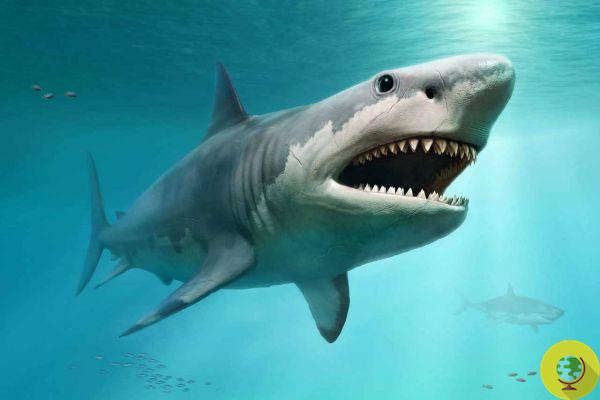
How big was the megalodon? The legendary but real shark, the largest ever, may have fewer secrets
How big was the megalodon? The legendary but real shark, the largest ever, may have fewer secrets. Scientists around the world have long been wondering about its characteristics. Now a group of students, by chance, revealed a fact that left the researchers speechless.
For more than a century, scientists have been trying to calculate the size of the megalodon, whose name means "big tooth". But the only known remains of the fearsome shark that dominated the oceans some 23 to 3,6 million years ago are fossilized teeth and some vertebrae. Like other sharks, the rest of the megalodon skeleton, including the jaw, was made up of light cartilage that rapidly decomposed after death. The tooth enamel, however, was very well preserved. Megalodon sharks lost thousands of teeth over the course of their lifetimes, leaving abundant traces of their species in the fossil record.
The last estimate is the result of some equations based on the width of the teeth and started with a high school lesson that went "wrong". Victor Perez, then a graduate student at the Florida Museum of Natural History, was guiding students through a math exercise that used 3D printed replicas of fossil teeth from a real megalodon and a set of commonly used equations based on tooth height to estimate the size of the shark. But at some point something strange happened: the students' calculations ranged from about 40 to 148 feet (about 45 meters) for the same shark, up from 65 previously estimated (about 19 meters).
But let's take a step back. Fossil collector Gordon Hubbell donated a nearly complete set of teeth from the same megalodon shark to the Florida Museum in 2015,. After museum researchers scanned the teeth and made them available online, Perez partnered with teacher Megan Higbee Hendrickson to incorporate them into the middle school curriculum at Tampa's Academy of the Holy Names.
We decided to have the kids 3D print the teeth, determine the size of the shark, and build a replica of its jaw for our art exhibit, Hendrickson said.
Perez and Hendrickson co-designed a lesson for students based on the then most popular method for estimating shark size: matching the tooth to its position in the shark's jaw, looking up the corresponding equation, measuring the tooth from the tip of the crown to the line where root and crown meet and connect the number to the equation.
After a perfectly successful pilot test with some teeth, the exercise was extended in a more complex way to high school students at Delta Charter High School in Aptos, California. Perez expected a slight variability of a couple of millimeters in their results, but this time, variations in the students' estimates reported a difference of more than 100 feet (about 30 meters). The farther a tooth position was from the front of the jaw, the higher the size estimate.
After Perez detailed the results of the lesson in a newsletter also aimed at scientists and researchers, he received an email from Teddy Badaut, a French paleontologist. Badaut suggested a different approach. Why not measure the tooth width instead of the height? Previous research had suggested that tooth width was limited by the size of a shark's jaw, which would have been proportional to its body length.
Ronny Maik Leder, then a postdoctoral researcher at the Florida Museum, set to work with Perez to develop a new set of tooth width equations.
In this way, the researchers analyzed the fossil teeth of 11 individual sharks, representing five species, including the megalodon, its close relatives and modern great white sharks.
By measuring the combined width of each tooth, they developed a model to estimate the width of a single tooth in relation to the jaw for a given species.
I was quite surprised that no one had ever thought about it before. The simple beauty of this method must have been too obvious to see. Our model was much more stable than previous approaches, said Leder, now director of the Natural History Museum in Leipzig, Germany.
Until now, the most accepted methods for estimating megalodon length have used the size of great white sharks as a reference, based on the relationship between tooth size and total body length. Although these creatures belong to different families, they share similar predatory lifestyles and large, triangular serrated teeth used for hunting. But these methods also presented a challenge: generating reliable estimates of body length required the researcher to correctly identify the previous location of a fossil tooth in a megalodon jaw. But as in humans, the size and shape of shark teeth vary depending on where they are in the mouth.
Perez cautioned that because individual sharks vary in size, this new method can have a 10-foot (about 30cm) margin of error.
While this potentially advances our understanding, we haven't really solved the question of how big the megalodon was. There is still a lot to do, but a complete skeleton would probably need to be found at this point
Perez concluded.
Reference source: Eurekalert,
READ also:
- Discovered the real dimensions of the Megalodon, the largest shark ever lived on Earth
- The virtual museum that allows you to interact with some extinct species thanks to augmented reality
- Exceptional discovery! Newborn megalodons were larger than an adult human


























